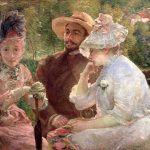
Paula Modersohn-Becker (1876–1907), a German painter and one of the early modernist artists, holds a significant place in the history of art for her pioneering role in the development of expressionism. Born on February 8, 1876, in Dresden, Germany, Modersohn-Becker’s short but impactful career made her a trailblazer in the exploration of new artistic forms and the representation of the female experience.
Modersohn-Becker received her artistic education at the School of Applied Arts in Bremen and later studied at the Worpswede artists’ colony near Bremen. It was at Worpswede that she formed connections with other artists, including Otto Modersohn, whom she would later marry. The couple played a crucial role in the development of the Worpswede art community.

Early in her career, Modersohn-Becker embraced post-impressionist and symbolist influences, demonstrating a penchant for portraying the human form and nature. However, her distinctive style began to emerge when she encountered the works of Cézanne and Gauguin during a trip to Paris in 1900. This exposure to modernist movements marked a turning point in her artistic journey.
honesty & Introspection
One of Modersohn-Becker’s notable contributions to art was her focus on the female nude as a subject. In a time when traditional norms dictated the portrayal of women in art, she challenged conventions by depicting the female form with a newfound honesty and introspection. Her self-portraits and representations of mothers and children, such as “Self-Portrait with an Amber Necklace” (1906) and “Reclining Mother and Child” (1906), are celebrated for their emotional depth and psychological insight.

Despite facing challenges and criticism for her unconventional approach, Modersohn-Becker persisted in her exploration of personal and universal themes. Her works often conveyed a sense of introspection and a connection to the spiritual, as seen in paintings like “Girl with a Jug” (1903) and “Three Girls in the Birch Forest” (1905).
persistence of paula
Tragically, Paula Modersohn-Becker’s life was cut short when she died of an embolism shortly after giving birth to her first child in 1907 at the age of 31. Despite the brevity of her career, her impact on the art world was substantial, and her legacy continued to grow in the subsequent decades.
Recognition of Modersohn-Becker’s contribution to art increased significantly posthumously, with retrospectives and exhibitions dedicated to her work. Her influence on expressionism, as well as her dedication to exploring the female experience in art, solidifies her status as a pioneering figure in the early 20th-century art scene.

In conclusion, Paula Modersohn-Becker’s biography is a testament to her groundbreaking contributions to the development of expressionism and her courageous exploration of the female form in art. Her legacy endures as an inspiration for artists challenging societal norms and seeking new avenues of self-expression.






